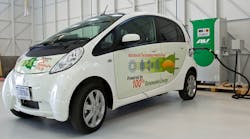Until recently, the prospects for wireless electric vehicle (EV) charging appeared limited, if a market developed at all. That has changed in the last 12 months. It is now clear that several major automakers are planning to bring wireless systems to market within the next few years, and a significant portion of the industry believes that wireless technology represents the future of plug-in electric vehicle (PEV) charging.
As of early 2014, there is only one commercial wireless charging system available for PEVs, an aftermarket system offered by Evatran and Bosch, and it is only available in North America. Automakers and their Tier One suppliers continue to be reticent on their plans for wireless EV charging. Most wireless charging systems are in the pilot phase and are likely to remain there for another 2 to 3 years. By 2015-2016, however, models with built-in wireless charging capability will be available from several major automakers. Within a decade, wireless charging could be the leading way of charging EVs. Navigant Research forecasts that wireless charging equipment for light duty vehicles will grow by a compound annual growth rate (CAGR) of 108% from 2013 to 2022, reaching annual sales of slightly less than 302,000 units in 2022.
A Navigant Research report analyzes the fledgling market for wireless charging systems for EVs. The study examines the technology of wireless EV charging and the efforts of technology developers, working in partnership with automakers, to bring systems to market. Global market forecasts for sales of wireless EV charging systems, segmented by region, extend through 2022. The report also looks at the demand drivers and market barriers associated with wireless EV charging, along with the efforts of automakers to incorporate wireless charging capability into their EV models.
Key Questions Addressed:
- What are the primary benefits and disadvantages of wireless electric vehicle (EV) charging?
- What are the technological issues associated with wireless EV charging?
- Who are the key players in developing wireless EV charging systems?
- How have the wireless EV charging strategies of the major automakers shifted in the last 6 to 12 months?
- What factors will determine the rate of adoption of wireless EV charging through 2022?
- How will the adoption of wireless EV charging influence the overall market for EVs?



